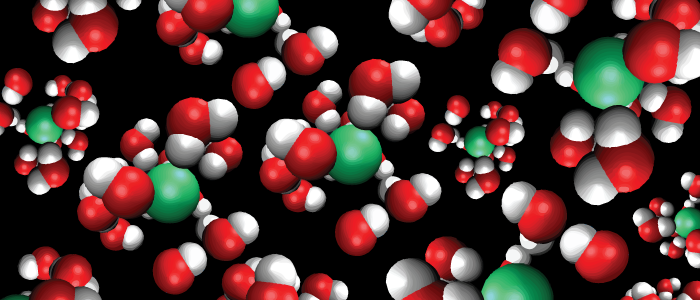Above: Beck conducted high-level quantum modeling to determine how the molecules align at the water’s surface and influence ion distributions and chemical reactions.
Recent research suggests that long-standing methods for calculating the thermodynamics of ion hydration, while robust, are ambiguous regarding the inclusion of water’s surface potential.
Why does this matter? Ions – molecules that have either a positive or negative charge – are at the center of chemical processes spanning electrical, biological, atmospheric and surfactant chemistries, to name a few. Water, the most important solvent for ions, is a polar molecule with positive and negative sides, which affects how the molecules align at the water’s surface and can influence ion distributions and chemical reactions.
“From classical simulations, we know that a proper treatment of ion and water polarization is important to accurately calculate hydration thermodynamics,” said Thomas Beck, Ph.D., a professor of chemistry at the University of Cincinnati. “However, our quantum calculations show that the current classical methodologies can over-estimate the polarization state of the ions, particularly for anions.”
People try to simulate ions in water by developing force fields, or a set of parameters and equations for use in molecular mechanics, and fitting them to experimental data such as the free energy values that may or may not include the surface potential. With inaccurate values, the models can be skewed.
Because single-ion quantities are not directly accessible to bulk thermodynamic measurement, a variety of approaches work to identify the contribution of the individual ion. If the hydration free energy – the energy that can be converted to work – and enthalpy – the energetic contribution – are obtained for this ion (the proton), then the corresponding values for all other ions can be measured.
Beck examined these methodologies by conducting a theoretical analysis of existing experimental data; the re-analysis shows significant size dependence to the derived proton hydration enthalpy when employing an expanded ion data set that includes a range of complex molecular ions. He then leveraged Ohio Supercomputer Center systems to conduct high-level quantum modeling that examined the size dependence of hydration enthalpy differences for a sodium flouride ion pair between the small cluster and the converged bulk thermodynamic limits.
“People have debated whether the values estimated by previous experimental approaches included the surface potential,” Beck said. “I think we proved that the current ‘gold standard’ experimental approach does. And, because we obtained a quantitative prediction for the surface potential that is outside the norm of what other people have set, it will surely stimulate discussion.”
Project Lead: Thomas Beck, University of Cincinnati
Research Title: Computational studies of specific ion effects in water and ion channels
Funding Source: National Science Foundation
Website: http://homepages.uc.edu/~becktl/index.html

